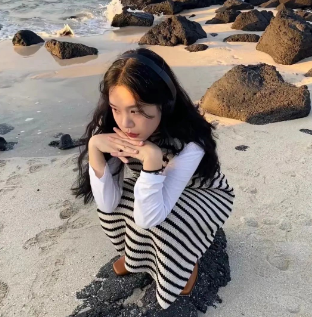EN
中
展览照片
Exhibition view
1 / 0
展期
Opening
2023.12.15
2023.12.15
策展
Curator
赵蕴资
Zoey Zhao
介绍
PRESS RELEASE
BLANKgallery 欣然在上海空间呈现艺术家王芊懿的首次个展。汇聚了芊懿近期的20幅画作,来源于希腊神话的灵感、人际关系和人文主题作为核心的系列创作。
BLANKgallery is pleased to present the first solo exhibition of Liioo Wang at the Shanghai space. The series consists of 20 paintings that weave together Qianyi's recent works inspired by Greek mythology, relationships, and humanistic topics as her centered practice.
《恩底弥翁》是希腊神话中月亮女神塞勒涅的恋人,牧羊人,每天夜间,塞勒涅都从空中飘下偷吻熟睡的牧羊人。然而女神偶尔一次的失职引起了主神宙斯的注意。以惩罚并清除人间对于女神的诱惑,恩底弥翁被惩罚选择任何形式的死亡或者在永恒的梦中青春永存,牧羊人选择了后者。恩底弥翁的传说共鸣着希腊神话中反复出现的关键主题,如二元性、爱情、美以及外部和内部关系的动态。这些深刻的概念在芊懿的画作中同样得到表达和探讨。
通过以当代视角再创作传统的希腊人物和原型,这些存在于不同时空和现实的角色成为了艺术家想要传达的信息的主体 。人物的诠释从西方叙事中汲取灵感,但它们有意摆脱了具体的领土标签。而是更多地体现了一种在西方和东方之间无缝流动的普遍性以及通用性地审美,超越在梦想效果与真实之间。
在美丽而忧郁的画面面纱下,人文观点得到被探讨和理解。绘画双重人物表达存在的二元性在《月光之影》、《玫瑰之歌》和《约翰与琼》得以体现。从外部看——他们与环境和所提供的语境的关系——这些描绘在画布上的角色在对话、爱情、挣扎和与其他角色的共存中,形成了互相反射的关系和类似双胞胎的纽带。从内部看——对角色与自己的关系——他们不断面对人性和神圣本质、男性和女性、生命和死亡、疯狂和理智之间的轴线。神话中所描述的在现实世界中亦如此。
起初呈现出梦幻般的质感,芊懿的画作唤起了一种神秘甚至优雅,将观众引入画面上人物的神秘世界。同时作品拥有艺术家独为己用的色调,常常是柔和的橙红色或透气而好奇的淡蓝色合成到画布创造出轻盈但细致微妙的质感。颜料被巧妙地捆绑和层叠,揭示了艺术家绘画过程中重要的工作方式——体会通过绘画将画布内化并随着它一同演变的旅程。 In Greek mythology, "Endymion" is the devoted shepherd and lover of Selene, the moon goddess. Each night, Selene descends down to steal kisses from the sleeping shepherd. After the occasional negligence of the goddess drew the notice, Zeus made decision to discipline the goddess from the mortal realm. Endymion was given the option to face any form of death or embrace the eternal sleep and he chose the latter by desiring to keep the youth and beauty. The story of Endymion resonates with crucial themes recurrent in Greek mythology, such as duality, love, beauty, and the dynamics of external and internal relationships. These profound concepts also find artistic expression and discussion in Qian Yi's paintings.
By reimagining traditional Greek characters and archetypes through a contemporary lens, Qianyi conveys messages through the agency of these characters live at dimensions of realities. The characters' interpretation drew inspiration from a Western narrative, yet they were intentionally devoid of specific territorial labels. Their appearances and aesthetics more overly embodying a universality that seamlessly flows between Western and Eastern transcend between dream effect and truth.
Under the beautiful and melancholy veil, humanistic views were understood. The manifestation of dual characters, symbolizing the existence of duality, is evident in the paintings "Moonlight Shadow," "Rose Song," and "John and Joan." Externally – how their relationship is with the environment and whatever context provided, these characters depicted on the canvas engage in communication, love, struggles, and coexistence with other characters, resembling a reflective relationship and a bond akin to twins. Internally – to the characters’ relationship with themselves, they perpetually confront the axis between human nature and divine essence, male and female, life and death, as well as madness and sanity. This is also true in the real world - just as it was described in the myths.
Initially exuding a dreamlike quality, the paintings evoke a sense of mystery and elegance, drawing the audience into the enigmatic world of the portrayed figures. The distinctive palette, often featuring a soft, blushed red or a breathable yet intriguing light blue, is delicately woven into the canvas, creating a lightweight yet nuanced texture. The paints intricately bound and layered onto the canvas, unveils a significant aspect of the painting process—a journey to internalize the canvas and evolve alongside it through the act of painting
通过以当代视角再创作传统的希腊人物和原型,这些存在于不同时空和现实的角色成为了艺术家想要传达的信息的主体 。人物的诠释从西方叙事中汲取灵感,但它们有意摆脱了具体的领土标签。而是更多地体现了一种在西方和东方之间无缝流动的普遍性以及通用性地审美,超越在梦想效果与真实之间。
在美丽而忧郁的画面面纱下,人文观点得到被探讨和理解。绘画双重人物表达存在的二元性在《月光之影》、《玫瑰之歌》和《约翰与琼》得以体现。从外部看——他们与环境和所提供的语境的关系——这些描绘在画布上的角色在对话、爱情、挣扎和与其他角色的共存中,形成了互相反射的关系和类似双胞胎的纽带。从内部看——对角色与自己的关系——他们不断面对人性和神圣本质、男性和女性、生命和死亡、疯狂和理智之间的轴线。神话中所描述的在现实世界中亦如此。
起初呈现出梦幻般的质感,芊懿的画作唤起了一种神秘甚至优雅,将观众引入画面上人物的神秘世界。同时作品拥有艺术家独为己用的色调,常常是柔和的橙红色或透气而好奇的淡蓝色合成到画布创造出轻盈但细致微妙的质感。颜料被巧妙地捆绑和层叠,揭示了艺术家绘画过程中重要的工作方式——体会通过绘画将画布内化并随着它一同演变的旅程。 In Greek mythology, "Endymion" is the devoted shepherd and lover of Selene, the moon goddess. Each night, Selene descends down to steal kisses from the sleeping shepherd. After the occasional negligence of the goddess drew the notice, Zeus made decision to discipline the goddess from the mortal realm. Endymion was given the option to face any form of death or embrace the eternal sleep and he chose the latter by desiring to keep the youth and beauty. The story of Endymion resonates with crucial themes recurrent in Greek mythology, such as duality, love, beauty, and the dynamics of external and internal relationships. These profound concepts also find artistic expression and discussion in Qian Yi's paintings.
By reimagining traditional Greek characters and archetypes through a contemporary lens, Qianyi conveys messages through the agency of these characters live at dimensions of realities. The characters' interpretation drew inspiration from a Western narrative, yet they were intentionally devoid of specific territorial labels. Their appearances and aesthetics more overly embodying a universality that seamlessly flows between Western and Eastern transcend between dream effect and truth.
Under the beautiful and melancholy veil, humanistic views were understood. The manifestation of dual characters, symbolizing the existence of duality, is evident in the paintings "Moonlight Shadow," "Rose Song," and "John and Joan." Externally – how their relationship is with the environment and whatever context provided, these characters depicted on the canvas engage in communication, love, struggles, and coexistence with other characters, resembling a reflective relationship and a bond akin to twins. Internally – to the characters’ relationship with themselves, they perpetually confront the axis between human nature and divine essence, male and female, life and death, as well as madness and sanity. This is also true in the real world - just as it was described in the myths.
Initially exuding a dreamlike quality, the paintings evoke a sense of mystery and elegance, drawing the audience into the enigmatic world of the portrayed figures. The distinctive palette, often featuring a soft, blushed red or a breathable yet intriguing light blue, is delicately woven into the canvas, creating a lightweight yet nuanced texture. The paints intricately bound and layered onto the canvas, unveils a significant aspect of the painting process—a journey to internalize the canvas and evolve alongside it through the act of painting
艺术家
ARTIST

王芊懿 (b.1995) 2022年毕业于韩国弘益大学视觉传达设计专业。王芊懿的绘画围绕神话故事亦或是对于梦境的叙述,相信梦境所描绘的都是不同层面不同维度的现实世界,夜性既灵性。拥抱随机性的创作方式,与画布生长,共创。 Liioo Wang (b.1995) graduated from Hongik University in South Korea majoring in visual communication design in 2022. Wang Qianyi's paintings revolve around mythological stories or narrations of dreams. He believes that dreams depict the real world at different levels and dimensions, and nighttime is spiritual. Embrace the random way of creation, grow with the canvas, and create together.
王芊懿 Liioo Wang




